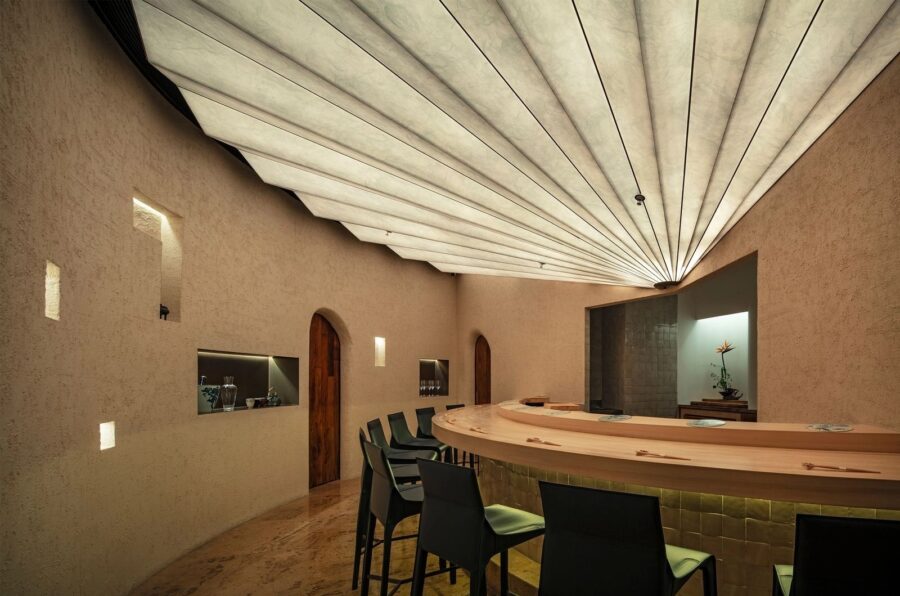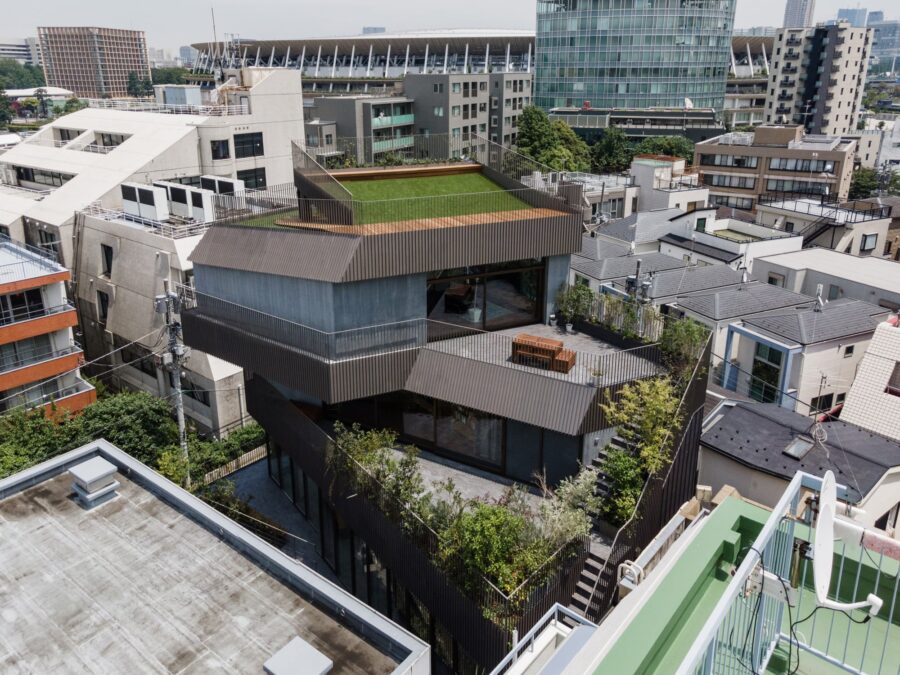長野県軽井沢のラウンドアバウト(六本辻)に面する建物のコンバージョンとフォリー(あずまや)の増築プロジェクト。コンバージョンは飲食店だった建物を、フレキシブルなワークスタイルに対応するワーケーションオフィスへと変更。緑豊かな木々に囲まれた敷地は約311坪で、既存建物の延床面積は約83坪。建物形状はラウンドアバウトを背に平屋部分と2階部分がV字のように繋がる。1階はエントランスホールを挟むかたちで50~60㎡ほどのSiteと呼ぶワークスペースが2つと、水回りやカフェを配置。また既存計画ではラウンドアバウト側に勝手口やサービスエリアを設けて閉じていたが、今回の計画では狭いながらも開口を設けることで、エントランスホールを風と光が通りぬけるスペースとした。
また交通量のあるラウンドアバウト側にカフェテラスを設けることで、コマーシャル力のあるファサードをつくり出している。2階は柱・梁・壁の構造補強を行い広々とした60㎡ほどのワンルームのSiteとし、さらに開口部の増設や拡張によって敷地内の緑があふれる空間とした。
この3つのSiteにはそれぞれ特徴があり、Site1は平面的な細長比が小さいことからセミナー開催に適し、Site2は3面開口からの自然光によりリラックスしたスモールグループワークが行え、Site3は2階という立地から物理的により高いセキュリティを確保している。企業に対しての短中長期の1棟貸しや部屋貸し、それらの利用がない時の個人貸し利用を想定するなかで、多様なニーズに応えるとともに、自分の居場所を見つけられるような空間づくりを行った。
コンバージョンならではの工夫としては、ケーブルラックを兼ねた長押を新たに設けることで、既存壁を壊さずに新規の照明器具やプロジェクターなどを配線できる仕組みとした。またその長押に呼応させるかたちで縦枠も設け、プロジェクターを投射する壁や、ホワイトボード壁などオフィスユースの機能をインテリア化させている。既存の外壁は一部に鏡や擬石が大胆に張られ時代を感じさせる仕上げであったため、その多くを周囲の緑が映えるグレーに塗装したスギ板張りで被いかぶせた。
外構においては動線の整備を行い、施設のアイコンとなるシラカバを中心に地域に則した植栽を増やす計画とした。その外構の一部に、休憩スペースとしてのフォリーを増築した。フォリーは屋根や庇や壁を兼ねた角度が異なる6枚のサーフェスから構成されている。フロアレベルは2つあり、低いほうは斜め壁を背に段差を利用して大きなベンチのように座れ、高いほうは足を投げ出して縁側のように開放的に座れる。またこのフォリーは通りからも見える位置に配置することにより軽井沢という厳しい景観規制のなかで、生まれ変わった施設の「何も書かないビルボード」としての役割も果たす。(田邉雄之)
Workation facility to improve the quality of work and refreshment
A conversion project of a commercial building which was used as a restaurant before into Workation offices that were to support a flexible working style. The building was located at the Roppon-tsuji roundabout in Karuizawa, Japan. The project was to convert and refurbish the site together with a newly installed folly. The site with rich greenery was 1028m² and the total floor area of the existing building was 274m².
The V-form building has two extending wings…one is one story and the other two stories…which meet at the vertex point facing the roundabout. On the ground level, each wing accommodates an office space of 50~60m², and they are placed sandwiching the entrance hall in between them together with the café and wet areas. The original plan placed the service area to the roundabout side, and hence the façade was designed to be completely closed. Although it was bijou, we decided to place the main reception area to the façade area, and that provided the entrance hall filled with light and breeze. Furthermore, we have also set a café terrace around the entrance, which also enhanced the attractiveness of the façade.
The first level was divided into small rooms before. We reinforced the structural columns, beams, and walls to remove the walls to create an extensive space of 60 ㎡. We have also inserted more windows and enlarged some existing ones so that the inside space could merge with the outside greenery.
From the conversion point of view, the Nageshi beams…beams running between columns in traditional Japanese rooms…which could be used as cabled racks, were installed. This enabled us to install wires for the additional lights and projectors without removing the walls. Also, as we wanted to offer the office-support functions as part of the interior design, we have set vertical frames in response to Nageshi to provide a wall where images from the projector could be presented and another which could be used as a whiteboard.
As the original structure lacked a floor heating system, we raised the floor level to form an insulation layer and set electric outlets. For the ventilation system, we have replaced the original one with a more energy-friendly machine and additionally set a ventilator with total heat exchanging function. There were mirrors and fake stones used for some part of the exterior, which was giving a sort of outdated somber image to the building. For that, we covered the part with cedar timber painted in grey that lent the building a blended charm with the surrounding trees.
For the landscape design, we have reorganized the lines of flow without changing the placements of the entrance and parking space. White birch has been the iconic tree of this facility. For that, we arranged more of it to be planted on the site together with other plants. A folly that was to be used as a space for relaxation was added in a part of the outside space. The folly consists of six surfaces of varied angles applied for the roof, eaves, and walls. The size and angles of these surfaces were considered according to the human scale of the activities that would likely be performed by the people there, as well as according to the angles of the sunlight and air pressure. Furthermore, the pitch width of plates was determined according to the simulation of the rainwater flow, which resulted in gradation from top to bottom.
There are two-floor levels in the folly. The lower one allows people to sit leaning against the inclined wall…it is like sitting on a large bench. The higher level allows people to sit more freely, like sitting on an Engawa, an edging strip of floor surrounding the inner part of a house in traditional Japanese architecture. The folly is placed visible from the street, and it works as a plain billboard for the reborn facility in Karuizawa with their strict building regulation for landscape preservation.
The new owner/management company assumes letting these office spaces for corporate business purposes for a mid to long term period as well as to the individual business needs. We aimed to create spaces where clients would feel comfortable working there and, at the same time, a facility that would be able to respond to the ever-changing business demands. (Yuji Tanabe)
* The definition of Workation described by Mitsubishi Estate
Workation is defined as working away from the main office, particularly in a place where the environment is nature-friendly and touristic, and staying in such a place for a mid to long period of time to conduct their work, including taking the training. People can at the same time enjoy touristy activities on weekends and after work. Workation is said to be a coined word from the western culture, which is a blend of work + vacation. Mitsubishi Estate particularly defines Workation as a combination of Vacation, Work, Location, Motivation, Communication, Innovation, and Working Style.
【WORK x ation Site 軽井沢】
所在地:長野県北佐久郡軽井沢町大字軽井沢字野沢原1323-1387
用途:ワーケーションオフィス、カフェ
クライアント:三菱地所
竣工:2019年
設計:田邉雄之建築設計事務所
担当:田邉雄之、小室周起
構造設計:ロウファットストラクチュア(既存建物)、シェルター(フォリー)
設備:Comodo設備計画
外構:hondaGREEN
家具:アクタス、林友ハウス工業
施工:竹花組
撮影:Yuji Tanabe
工事種別:コンバージョン
構造:木造
規模:地上2階、平屋
敷地面積:619.02m²
建築面積:222.35m²(既存建物)、22.35m²(フォリー)
延床面積:75.91m²(既存建物)、11.91m²(フォリー)
設計期間:2019.10-2020.06
施工期間:2020.02-2020.07
【WORK x ation Site KARUIZAWA】
Location: 1323-1387, Oaza Karuizawa aza Nozawahara, Karuizawa-machi, Kitasaku-gun, Nagano, Japan
Principal use: Workation office, Cafe
Client: MITSUBISHI ESTATE
Completion: 2020
Architects: Yuji Tanabe Architects
Design team: Yuji Tanabe, Shuki Komuro
Structure engineer: LOW FAT Structure / Existing, Shelter / Folly
Mechanical: comodo
Landscape: hondaGREEN
Furniture: ACTUS, Rinyu House-kogyo
Contractor: Takehanagumi
Photographs: Yuji Tanabe
Construction type: Conversion
Main structure: Wood
Building scale: 2 stories and 1 below
Site area: 619.02m²
Building area: 222.35m² / Existing, 22.35m² / Folly
Total floor area: 75.91m² / Existing, 11.91m² / Folly
Design term: 2019.10-2020.06
Construction term: 2020.02-2020.07








